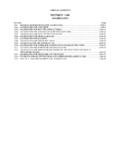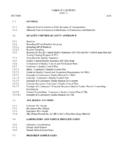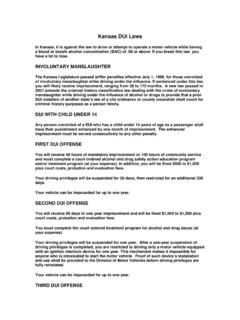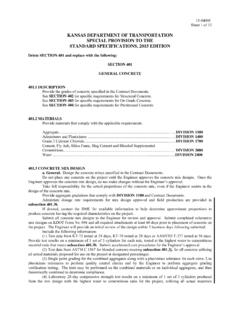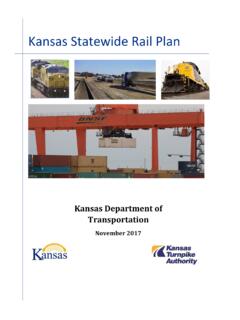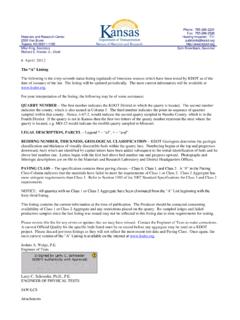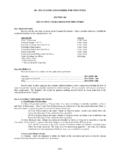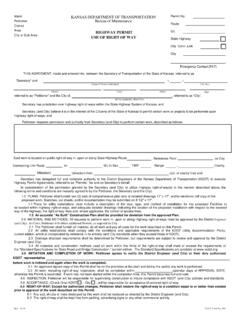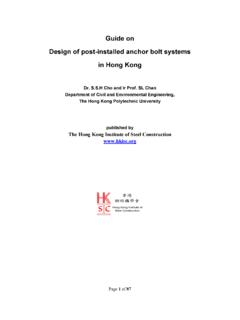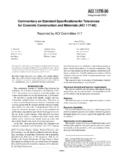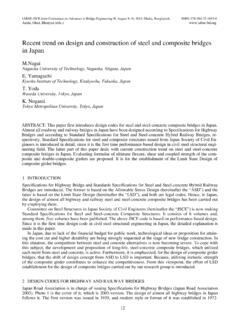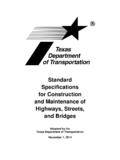Transcription of 1705 – EPOXY-RESIN-BASE BONDING SYSTEMS …
1 1705 EPOXY-RESIN-BASE BONDING SYSTEMS FOR concrete SECTION 1705 EPOXY-RESIN-BASE BONDING SYSTEMS FOR concrete DESCRIPTION This specification covers two-component, epoxy -resin BONDING SYSTEMS for application to portland cement concrete , which are able to cure under humid conditions and bond to damp surfaces, and comply with the AASHTO M 235 (ASTM C 881). a. Seven types of SYSTEMS are covered by this specification. (1) Type I - For use in non-load bearing applications for BONDING hardened concrete to hardened concrete and other materials, and as a binder in epoxy mortars or epoxy concretes. (2) Type II - For use in non-load bearing applications for BONDING freshly mixed concrete to hardened concrete . (3) Type III - For use in BONDING skid-resistant materials to hardened concrete , and as a binder in epoxy mortars or epoxy concretes used on traffic bearing surfaces (or surfaces subject to thermal or mechanical movements).
2 (4) Type III Overlay- For use in multi-layer polymer concrete overlay, and as a binder in epoxy mortars or epoxy concretes used on traffic bearing surfaces (or surfaces subject to thermal or mechanical movements). (5) Type IV - For use in load bearing applications for BONDING hardened concrete to hardened concrete and other materials, and as a binder for epoxy mortars and concrete . (6) Type V - For use in load bearing applications for BONDING freshly mixed concrete to hardened concrete . (7) Type VI - For BONDING and sealing segmental pre-cast elements with internal tendons and span-by-span erection when temporary post tensioning is applied. (8) Type VII - For use as a non-stress carrying sealer for segmental pre-cast elements when temporary post tensioning is not applied as in span-by-span erection. b. Three grades of SYSTEMS are covered by this specification. (1) Grade 1 - Low viscosity ( Pa) (2) Grade 2 - Medium viscosity ( Pa) (3) Grade 3 - Non-sagging consistency.
3 C. Classes A, B, and C are defined for Types I through V, and Classes D, E, and F are defined for Types VI and VII, according to the range of temperatures for which they are suitable. The temperature in question is usually that of the surface of the hardened concrete to which the BONDING system is to be applied. This temperature may be considerably different from that of the air. Where unusual curing rates are desired, it is possible to use a class of BONDING agent at a temperature other than that for which it is normally intended. For example, a Class A system will cure rapidly at room temperature. Any deviation of this sort must be approved by the Engineer before application. Classes are defined as follows: (1) Class A - For use below 40 F. The lowest allowable temperature is defined by the manufacturer of the product.
4 (2) Class B - For use between 40 and 60 F. (3) Class C - For use above 60 F. The highest allowable temperature is defined by the manufacturer of the product. (4) Class D - For use between 40 and 65 F. (5) Class E - For use between 60 and 80 F. (6) Class F - For use between 75 and 90 F. REQUIREMENTS Provide material that complies with AASHTO M 235 (ASTM C 881), is the type and grade specified in the Contract Documents, and is the class appropriate for the temperature at the time of use, as designated by the manufacturer. 1700-8 1705 EPOXY-RESIN-BASE BONDING SYSTEMS FOR concrete For Type III Overlay, Grade 1 or 2, 100 percent solids, thermosetting, moisture-insensitive epoxy , that complies with AASHTO M 235 (ASTM C 881), with the following exceptions in TABLE 1705-1: TABLE 1705-1: ADDITIONAL REQUIREMENTS FOR TYPE III OVERLAY epoxy Property Requirement Test Method Viscosity 7-25 poises ASTM D2393, Brookfield RVT, Spindle No.
5 3 at 20 RPM Gel Time 15-45 min. ASTM C 881, para. modified, 50 to 100 ml sample. Compressive Strength*, 3 hr. 1000 psi min. ASTM C 109, w/ plastic inserts Compressive Strength*, 24 hr. 5000 psi min. ASTM C 109, w/ plastic inserts Tensile Strength, 7day 2000-5000 psi ASTM D 638 Elongation, 7 days 30-70 percent ASTM D 638 Adhesive Strength, 24 hr. 250 psi min. ACI 503R, Appendix A *Mixed with aggregate. TEST METHODS As specified in AASHTO M 235 (ASTM C 881). PREQUALIFICATION a. All epoxy resin SYSTEMS intended for use under this specification must be prequalified on the basis of Type, Grade and Class prior to use. Manufacturers desiring to supply material for KDOT jobs must submit a written request to the Bureau Chief of Materials and Research, with the following information for each type and brand name: (1) Name, address and telephone number of the manufacturer.
6 Include the name of the preferred contact person. (2) Brand name of the material. (3) Type, Grade and Class of the material. (4) Information regarding recommended usage and application instructions. (5) Material Safety Data Sheets. (6) One copy of a certified test report prepared by a laboratory regularly inspected by the Cement and concrete Reference Laboratory (CCRL) of the National Institute of Standards Technology or other approved reference laboratory, showing test results complying with AASHTO M 235 (ASTM C 881). Include evidence that the laboratory is inspected regularly. (7) For Type III Overlay epoxy , include a Fourier Transform Infrared Spectrophotometry (FTIR) spectrum in transmittance mode and a bulk sample of each component tested. All data will be maintained as confidential and used only for QA/QC purposes. (8) For Self-contained epoxy SYSTEMS , provide 6 samples for testing at MRC.
7 All liquid components will be fingerprinted using infrared spectroscopy for use in screening future verification samples to verify that materials submitted for use are of an identical formulation as originally approved. b. The information and test reports will be reviewed by the Bureau Chief of Materials and Research. The manufacturer will be advised as to whether or not the product is prequalified. For Type III Overlay epoxy , prequalification is dependent upon a three-year satisfactory performance in the field. Proof or performance at non-KDOT projects in Kansas may be submitted to show satisfactory performance history in Kansas. c. The Bureau of Materials and Research will maintain a list of prequalified epoxy resin SYSTEMS . Products will remain prequalified as long as the formulation and manufacturing processes remain unchanged, and field experience indicates that the material functions appropriately.
8 Changes in formulation or manufacturing processes will require new prequalification testing. Failure of the material to function appropriately in the field will be cause for removal of the product from prequalified status. Products removed from prequalified status will be considered for requalification if the manufacturer can provide evidence that the cause of failure has been positively identified, 1700-9 1705 EPOXY-RESIN-BASE BONDING SYSTEMS FOR concrete and necessary formulation changes and quality control measures have been implemented to eliminate that cause. Complete prequalification testing may be required for products that have been removed from prequalified status. d. Verification samples will be taken and forwarded to the MRC for testing. Failure of such samples to comply with the specification requirements may be cause for removal of the product from prequalified status.
9 BASIS OF ACCEPTANCE Prequalification as specified in subsection Receipt and approval of a Type C certification as specified in DIVISION 2600. Observation of performance at the project to verify that the epoxy is effective for the specified purpose. For Type III Overlay, the Engineer will accept the epoxy on the basis of the certified laboratory report, and the Infrared Spectrum analysis of the field samples. 1700-10
